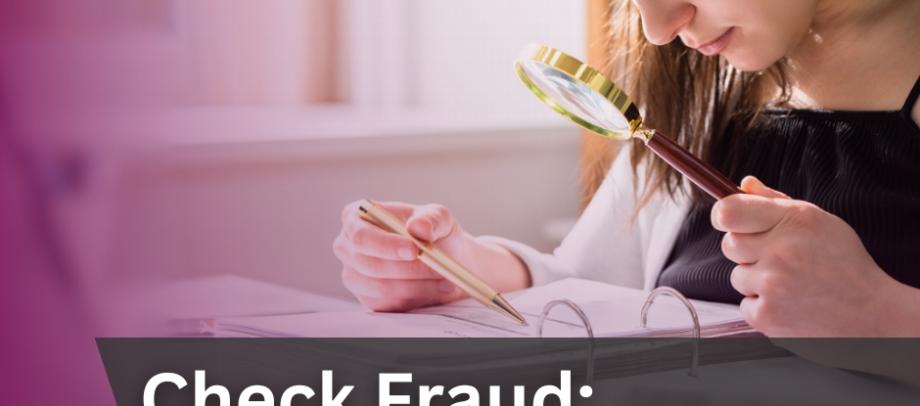
3 Tips for Preventing Check Fraud
Here's how to spot common tactics and protect yourself.
Check Fraud is on the rise.
According to a recent report from the U.S. Department of the Treasury, check fraud has increased nationwide by 385% since the pandemic.
As tactics become more sophisticated, recognizing the warning signs of check fraud is increasingly crucial to safeguarding your finances and personal information.
In this article, we will:
- Identify some typical schemes fraudsters use.
- Offer practical prevention tips.
- Provide guidance on how to respond if you become a victim.
What is Check Fraud?
According to the U.S Department of the Treasury, check fraud is among the quickest growing forms of financial crime in the U.S. It involves the production and use of checks for the express purpose of accessing or acquiring funds that the person does not have ownership of.
Why Does Check Fraud Succeed?
The checks scammers utilize today resemble the real thing so closely that bank employees are often unaware of the fraud. Additionally, these scams may prey upon populations already predisposed to misinformation about the security of their financial information.
What Does Check Fraud Look Like?
Here some common tactics:
Excess of Purchase Price
More commonly known as the “Overpayment” scam, the “Excess of Purchase Price” scam preys on people with items to sell. According to the Federal Trade Commission (FTC), the scam begins when a scammer purchases an item with a check for more than the purchase price. The scammer then asks that the seller wire the difference back to them.
Don’t. It is a scam. The check is fake, and in the end, you will be on the hook for the entire purchase amount.
Check Washing or Check Cooking
“Check Washing” involves the theft of a physical check, from a P.O. box or a personal mailbox. Criminals will then use chemicals to “wash” the check and erase all writing except the signature. They then write a new amount and address the check to themselves or an alternate identity.
The “Check Cooking” process is similar, except it’s done electronically. Criminals require at least an image of a check, but instead of “washing” it, they scan and alter it digitally before printing out the new check.
Lottery or Sweepstakes
Have you ever received an email or letter claiming that you won a prize but first needed to send money to cover shipping and handling? Chances are that was a scam, and any money you sent did not come back in the form of your “Grand Prize.”
How Can You Prevent Check Fraud?
Here are three tips:
1. Make Digital Payments
One surefire way to reduce the number of checks you write is to utilize digital payment options, such as Google PayTM or Apple Pay®. The alternatives not only lessen the chance of check fraud occurring, but also the chance that someone may steal a check from your mail.
2. Use Your Bank’s Bill Pay Service
As online banking has become more popular, many banks have introduced online bill pay programs as a way to manage your finances without having to deal with undue paperwork. These programs also have the added bonus of being completed without human intervention. Not only do they allow for greater financial flexibility, but payments are made electronically or via check, with all the information being printed rather than handwritten.
3. Change Your Pen
As crazy as it sounds, one of the easiest things you can do to protect yourself against check fraud is to use a black gel pen when filling out a check. Water-based inks are thicker and contain different chemicals than those found in normal ink, making “washing” checks much more difficult.
What if You Fall Victim?
Here are three outlets you can contact to report suspected fraud:
1. The FTC
The FTC, or Federal Trade Commission, was founded with consumer protections in mind. By spending just a few minutes filing a fraud report with the FTC, you are not only enlisting the help of the over 2,800 enforcement officers the FTC employs, but you are also helping to prevent further information from being stolen from yourself and others.
To file a report with the FTC, please visit reportfraud.ftc.gov.
2. U.S Postal Inspection Service
The U.S Postal Inspection Service is responsible for enforcing all legal statutes related to the Post Office as well as protecting the employees, facilities, and customers of the USPS.
To file a report with the U.S Postal Inspection Service, go to uspis.gov/report or call (877) 876-2455.
3. Illinois Attorney General
Tasked with protecting the public interest of Illinois and its people, the Attorney General's Office is a comprehensive and competent source of information on financial security, amongst many other topics.
To register a fraud complaint with the Office of the Illinois Attorney General, please visit illinoisattorneygeneral.gov/Contact/ and hit the “File a Complaint” button or call (217) 782-1090.
How Are We Keeping You Safe?
At the State Bank of Bement, we offer a variety of fraud protection and prevention services, including MyCardRules, our transaction alert system, which will alert you to any suspicious activity on your check card.
Additionally, we offer online Bill Pay, a digital solution to the headache of manually paying all your monthly bills.
Explore our Fraud Protection page for more information on safeguarding your account from fraud and details on MyCardRules enrollment.
For around-the-clock access to your account, sign up for Mobile Banking.
-Member FDIC

